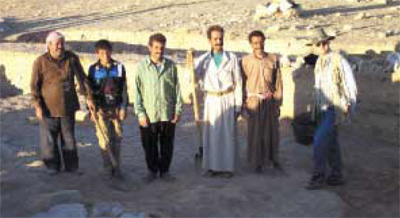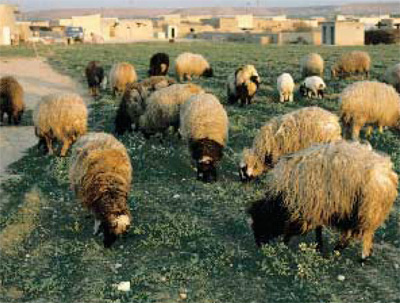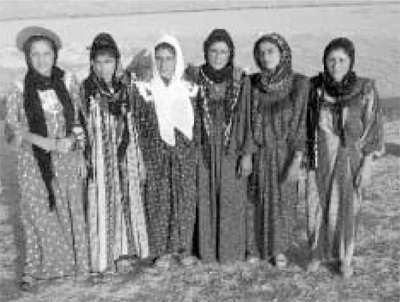
Try as we might to avoid the romantic image of archaeologists roughing it in the field, that ’s precisely what we do each dig season at the Tell es-Sweyhat Archaeological Project in Syria. Nafila, the village that houses the Tell es-Sweyhat dig team, is a sleepy farming community of mud brick houses inhabited by the formerly nomadic pastoralist Shafraat tribe. Separated by four kilometers of dirt road, Tell es-Sweyhat and Nafila occupy the center of a small crescent-shaped valley bounded on three sides by steep outcroppings of a limestone plateau and on the fourth by the Euphrates River. From the air, Nafila resembles a small island of rectangular houses, sheepfolds, and courtyards amid a patchwork quilt of parched barley fields and verdant plots of cotton, sesame, sunflowers, and melons. The occasional solitary tree in the valley is cherished and well guarded by its owner. Nearly every feature in the bleached landscape surrounding Nafila reflects light at blinding intensity. The region receives little rain and is notorious for extremes of temperature.
Villagers scratch out an existence cultivating the great Mesopotamian triumvirate of barley, sheep, and goats. They supplement their incomes working as day laborers. Women pick cotton in the fields of local tribal elites, and men travel farther afield, for jobs in the construction and petroleum industries. For financial and social reasons, the dig is a much-anticipated event. Extended families often work as teams on the excavations, so each day is like a paid family reunion. Digs pay young men far less than construction work, but the hours are shorter, the work less backbreaking. Most important, they are reunited with their families after long, often melancholy, absences.

During each field season, we must meet the needs of 10 to 15 researchers and coordinate the movements of 70 workers and household staff. Adding to the challenge, Nafila has no source of potable water. We regularly bring drinking water from a treatment facility 20 minutes away.Our cooks shop in the small city of Raqqa, an hour and a half away driving on a treacherous stretch of highway. Until two years ago there was no electricity. Our lights, refrigerator, and other equipment were run by generators, which needed constant repair. In the computer age, electricity ensures that staff can work in the evenings, and refrigeration is a must, not so much for cold beer as for storing diabetic staff members’ insulin.
With the nearest medical facility an hour’s drive away, we do not tempt fate when it comes to sanitary living conditions and a dependable supply of food and water. First-timers are more prone to “Nafila Malaise,” and we anticipate sudden illness and panicked sprints to the nearest privy, a run we have glibly dubbed the Sweyhat Dash. We admit to having had a few new staffers threaten to leave during the field season, either from culture shock or illness, or some combination thereof. The relative isolation and the fact that we have only one vehicle and an unwaveringly faithful driver deter most escapes.

Electricity has removed some of the novelty of life in Nafila. In the “old days” (I increasingly sound like my grandparents), we slept outdoors, as summer nights were pleasantly cool, if not “critter free.” Evenings are spent socializing in the courtyards, and most people sleep outdoors on specially constructed platforms or on rooftops. But gone are the days of peacefully drifting to sleep under an unobstructed view of the heavens. A new measure of prosperity in northern Syria is an uninterrupted supply of electricity and ample appliances. Most are decorated with fluorescent lights. Courtyards are illuminated with security lights. Stargazing is a lost art.
Over the years, I have felt as if the Shafraat have adopted us. They have generously opened their tight-knit community to an admittedly eccentric assortment of archaeologists, providing a cozy home and a skilled excavation crew. The project could not succeed without their unstinting support, resourcefulness, and patience. Shafraat hospitality is true to the village’s name, Nafila, which means “to give something freely.”
Digging In Arabic
The language barrier always makes life in Syria interesting. While I can extol in unbroken Arabic the virtues of apricot-wood pick handles versus the cheaper poplar alternative or the merits of various brands of trowels, I still have difficulty making a hotel reservation by phone. Much of the problem stems from the dialect of Arabic we speak. Ancient-language instruction is usually an integral part of Near Eastern archaeologists’ training, but modern Arabic is not. New supervisors become masters at acting out work instructions. In dig notebooks, we often find phrase lists and odd sketches — a sure sign that verbal communication has failed. Most archaeologists learn the language while excavating. Once we know enough Arabic to run an excavation, the rate of absorption tends to decrease.
My first verb was “to dig,” followed shortly by the useful phrases “Stop,” ” Leave it (in the ground),” and ” I ‘m not in charge here, ask my dissertation adviser.”
Michael D. Danti is research specialist in the University of Pennsylvania Museum’s Near East Section and field director at Tell es-Sweyhat, where he has worked since 1991.
